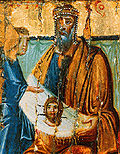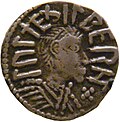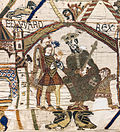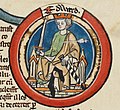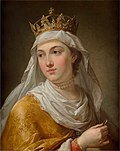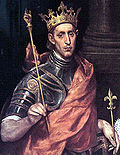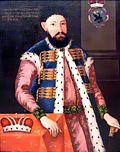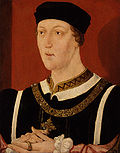Monarchs
This section enumerates Christian sovereigns, as opposed to mere consorts, who are enumerated in "Other royalty and nobility" below.
Saints
| Image | Name | Recognized By | Sovereignty | Notes |
|---|---|---|---|---|
| Abgar V of Edessa | Catholic, Eastern Orthodox | King of Osroene [1] | The first Christian monarch in history. | |
| Ælfwald I of Northumbria | Locally venerated | King of Northumbria | ||
| Æthelberht of Kent | Catholic, Eastern Orthodox | King of Kent | Listed in the 1916 edition of the Roman Martyrology under February 24. [2] | |
| Æthelberht II of East Anglia | Catholic, Eastern Orthodox | King of East Anglia | ||
| Alfred the Great | Catholic, [3] Eastern Orthodox, Anglican | King of Wessex | ||
| Amadeus IX, Duke of Savoy | Catholic | Duke of Savoy | ||
| Brian Boru | Catholic [4] [5] | High King of Ireland | ||
| Brychan Brycheiniog [6] [7] | Catholic, [8] [9] Eastern Orthodox [10] | King of Brycheiniog | ||
| Canute IV of Denmark | Catholic | King of Denmark | ||
| Causantín mac Cináeda | Catholic | Kings of the Picts (Catholic) | [11] | |
| Ceolwulf of Northumbria | Catholic, Anglican | King of Northumbria | ||
| Charles I of England and Scotland | Anglican [12] | King of England and King of Scotland | Commonly referred to as King Charles the Martyr | |
| Charles the Good | Catholic | Count of Flanders | ||
| Clovis I | Catholic, Eastern Orthodox | King of the Franks | ||
| Constantine of Cornwall | Catholic | King of Dumnonia | Martyr [13] | |
| Constantine of Strathclyde | Catholic, Eastern Orthodox | King of Strahclyde | ||
| Constantine I | Catholic, Eastern Orthodox | Roman Emperor | Constantine is not revered as a saint but as “the great” in the Latin Catholic Church. [14] [15] Eastern Catholic Churches such as the Ukrainian Catholic Church recognize him as a saint. [16] | |
| Constantine XI Palaiologos | Catholic (Byzantine Rite) | Byzantine Emperor | Not formally canonized, considered a "National Martyr" (unofficial) | |
| Cormac mac Cuilennáin | Catholic, Eastern Orthodox | King of Munster | ||
| Cynehelm | Catholic, Eastern Orthodox, Anglican | Kingdom of Mercia | His status as co-ruler of Mercia is usually considered to be legendary | |
| Dagobert II | Catholic | King of Austrasia | Son of Sigbert III | |
| David I of Scotland | Catholic [17] | King of Scotland | Son of Saint Margaret of Scotland | |
| Eberhard of Friuli | Catholic [18] | Duke of Friuli | Son-in-law of Frankish emperor Louis the Pious and ancestor of all contemporary royals (Catholic) | |
| Edmund the Martyr | Catholic, Eastern Orthodox | King of East Anglia | ||
| Edgar the Peaceful | Catholic, Eastern Orthodox | King of the English | Feast day is 8 July | |
| Edward the Confessor | Catholic, Eastern Orthodox | King of England | ||
| Edward the Martyr | Catholic, Eastern Orthodox | King of England | Martyr | |
| Edwin of Northumbria | Catholic, Eastern Orthodox | King of Deria & Bernicia | ||
| Kaleb of Axum | Catholic, Eastern Orthodox, Oriental Orthodox | King of Ethiopia | Also known as Saint Elesbaan | |
| Eric IX of Sweden | Catholic | King of Sweden | Martyr, feast day of May 18. | |
| Ezana of Axum | Catholic, Eastern Orthodox, Oriental Orthodox | King of Axum | 4th century King of Axum [19] [20] | |
| Fedelmid mac Crimthainn | Catholic, Eastern Orthodox | King of Munster | ||
| Ferdinand III of Castile | Catholic | King of Castile and Toledo | Known as "Ferdinand III the Saint", in Spanish "San Fernando" and "Fernando III el Santo" | |
| Guntram | Catholic, Eastern Orthodox | King of Orléans, King of the Franks | Merovingian king of Burgundy (Catholic); The Catholic Church celebrates his feast day on 28 March. | |
| Henry II, Holy Roman Emperor | Catholic, Eastern Orthodox | Holy Roman Emperor | Husband of Cunigunde of Luxemburg (see under "Other royalty and nobility" below), known as "Saint Henry II", in German "Heinrich II. der Heilige" ("Henry II the Holy") | |
| Hermenegild of the Visigoths | Catholic, Eastern Orthodox | Martyr | ||
| Hoel, King of Cornouaille | Catholic, Eastern Orthodox, Anglican | King of Cornouaille | Hoel appears in Welsh mythology and the Matter of Britain as a "king of Brittany". Mythology states that he was a relative of the legendary King Arthur. | |
| Jadwiga of Poland | Catholic | Queen of Poland | Known as "Saint Hedwig of Poland", "Saint Jadwiga, Queen of Poland" and "Saint Hedwig, Queen of Poland", in Polish "Św. Jadwiga Królowa Polski" | |
| Judicael of Brittany | Catholic | King of Domnonée | ||
| Justinian I | Eastern Orthodox, Lutheran | Byzantine emperor | Died 565, known as "Justinian the Great" | |
| Ladislaus I of Hungary | Catholic | King of Hungary | ||
| Leopold III | Catholic | Margrave of Austria | ||
| Lucius of Britain | Catholic, Eastern Orthodox | King of the Britons | 2nd century British King, whose historicity is disputed | |
| Louis IX of France | Catholic | King of France | in French "Saint Louis" | |
| Ludwig IV of Thuringia | Catholic | Landgrave of Thuringia | Husband of Elisabeth of Hungary (see under "Other royalty and nobility" below), not canonized but revered as a saint in Thuringia, in German Ludwig IV., der Heilige (Ludwig IV the Holy) (Catholic) | |
| Magnus of Orkney | Catholic Church, Anglican Church, Church of Sweden, Church of Norway | Earl of Orkney | 12th century Earl of Orkney, and Martyr | |
| Malcolm III of Scotland [21] | Catholic | King of Scotland | Scottish Gaelic: Máel Coluim mac Donnchada | |
| Malcolm IV of Scotland | Catholic [22] | King of Scotland | ||
| Olaf II of Norway | Catholic, Eastern Orthodox | King of Norway | ||
| Oswald of Northumbria | Catholic, Eastern Orthodox | King of Northumbria | Martyr; feast day is August 5. | |
| Oswine of Deira | Catholic, Eastern Orthodox | King of Deira | Martyr, died 651. | |
| Pabo Post Prydain | Catholic | King from Hen Ogledd | Traditionally identified with St. Pabo (Catholic) [23] | |
| Pompeia of Langoat | Catholic | Queen of Brittany, perhaps legendary. | ||
| Salomon | Catholic | King of Brittany | 9th century Martyr and King of Brittany | |
| Sigebert III | Catholic | King of Austrasia | Merovingian king of Austrasia, father of Dagobert II (Catholic) | |
| Sigismund of Burgundy | Catholic, Eastern Orthodox | King of the Burgundians | ||
| Stephen I of Hungary | Catholic, Eastern Orthodox | King of Hungary | ||
| Tiridates III of Armenia | Catholic, Oriental Orthodox, Armenian Church | King of Armenia | [24] [25] | |
| Vladimir I of Kiev | Eastern Orthodox | Grand Prince of Kiev | First Christian ruler of Kiev, in the Russian Orthodox Church his title denotes "equal to the Apostles", in Russian "Владимир Святой", in Ukrainian "Володимир Святий" and "Святий рівноапостольний князь Володимир" ("Saint Equal-to-the-Apostles Duke Volodymyr") (Catholic, [26] Eastern Orthodox) | |
| Wenceslaus I, Duke of Bohemia | Catholic, Eastern Orthodox | Duke of Bohemia | Died 28 September 935, Martyr, patron of the Czech Republic, in Czech "Svatý Václav", in German "Heilige Wenzel" | |
| Wigstan of Mercia | King of Mercia | Later became a monk. | ||
| William of Gellone | Catholic | Count of Toulouse | ||
Saints exclusively in Eastern Orthodox religion
| Image | Name | Recognized By | Sovereignty | Notes |
|---|---|---|---|---|
| Alexander Nevsky | Eastern Orthodox [27] | Prince of Novgorod, Grand Prince of Kiev, & Grand Prince of Vladimir | ||
| Andrey Bogolyubsky | Eastern Orthodox | Grand Prince of Vladimir | ||
| Archil of Kakheti | Eastern Orthodox | Prince of Kakheti [28] | Martyr | |
| Ashot I of Iberia | Eastern Orthodox | Prince of Iberia | Martyr | |
| Boris I of Bulgaria | Eastern Orthodox [29] | Knyaz of Bulgaria | ||
| Constantin Brâncoveanu | Eastern Orthodox [30] | Prince of Wallachia | Martyr | |
| Constantine IV | Eastern Orthodox | Roman Emperor | ||
| David IV of Georgia | Eastern Orthodox | King of Georgia | ||
| David of Trebizond | Eastern Orthodox [31] | Emperor of Trebizond | ||
| Demetrius I of Georgia | Eastern Orthodox | King of Georgia | ||
| Demetrius II of Georgia | Eastern Orthodox | King of Georgia | Martyr, also known as "Demetre the Self-Sacrificer" | |
| Stefan Dragutin | Eastern Orthodox | King of Serbia | ||
| John III Doukas Vatatzes | Eastern Orthodox | Emperor of Nicaea | Died 1254, known as "John the Merciful" and "John III Doukas Vatatzes" | |
| John IV Laskaris | Eastern Orthodox | Emperor of Nicaea | Died 1305, known as "John IV Laskaris" and "John IV Doukas Laskaris" [32] | |
| Justinian II | Eastern Orthodox | Byzantine emperor | Died 711, known as "Justinian Rhinotmetos" ("ὁ Ῥινότμητος", "the slit nosed") | |
| Lazar Hrebeljanović | Serbian Orthodox Church | Knez ("Prince" or "Duke") of Serbia | Died 1389, known as "Tsar Lazar", canonized by the Serbian Orthodox Church as "Свети Косовски Великомученик кнез Лазар" ("Holy Great-Martyr of Kosovo Prince Lazar"), known as "Свети Цар Лазар" ("Holy Tsar Lazar") (Serbian Orthodox) | |
| Leo I the Thracian | Eastern Orthodox | Roman Emperor | Died 474 | |
| Luarsab II of Kartli | Eastern Orthodox | King of Kartli | Martyr | |
| Manuel II | Eastern Orthodox | Roman Emperor | Died 1425, known as "Manuel I Palaiologos" and "Manuel the Monk" | |
| Marcian | Eastern Orthodox | Roman Emperor | Died 457 | |
| Mikhail of Tver | Eastern Orthodox | Grand Prince of Vladimir | Martyr | |
| Milutin Nemanjic | Eastern Orthodox | King of Serbia | Martyr | |
| Mirian III of Iberia | Eastern Orthodox | King of Iberia | Died 361 | |
| Neagoe Basarab | Eastern Orthodox | King of Wallachia [33] | ||
| Nicholas II of Russia | Eastern Orthodox | Czar of Russia | The Russian Orthodox Church Outside Russia canonized him in 1980 as a saint and martyr, the synod of the Russian Orthodox Church canonized him as a saint and passion bearer on 14 August 2000, in Russian "Царь-Мученик Николай II" ("Tsar-Martyr Nicholas II") and "Святой Страстотерпец Царь Николай II" ("Holy Passion-Bearer Tsar Nicholas II") (Eastern Orthodox); [34] see Canonization of the Romanovs | |
| Nikephoros II | Eastern Orthodox | Roman Emperor | Died 969. | |
| Peter of Murom | Eastern Orthodox | Prince of Murom | Husband of Saint Fevronia of Murom | |
| Peter I of Bulgaria | Eastern Orthodox | Tsar of Bulgaria | He was the Tsar of the First Bulgarian Empire. | |
| Solomon II of Imereti | Eastern Orthodox | King of Imereti | ||
| Stefan Lazarević | Eastern Orthodox | Despot of Serbia | Known as "Stefan the Tall." He first ruled as a Prince of Serbia and then became despot. | |
| Stefan Nemanja | Eastern Orthodox | Grand Prince of Serbia | Canonized as Saint Simeon the Myrrh-streaming | |
| Stefan Nemanjić | Eastern Orthodox | Grand Prince and King of Serbia | Known as Stefan the First-Crowned | |
| Stefan Uroš III | Eastern Orthodox | King of Serbia | Known also as Stefan Decanski | |
| Stefan Uroš V | Eastern Orthodox | Emperor of Serbia | ||
| Stephen the Great, King of Moldavia | Eastern Orthodox | repaused 2 July 1504 | ||
| Tamar of Georgia (died 1213) | Georgian Orthodox Church (Eastern Orthodox) | Queen of Georgia | ||
| Theodosius I, Roman Emperor (died 395) | Eastern Orthodox | Roman Emperor | ||
| Theodosius II, Roman Emperor (died 450) | Eastern Orthodox | Roman Emperor | ||
| Vakhtang I of Iberia | Eastern Orthodox | King of Iberia | ||
| Vakhtang III of Georgia | Eastern Orthodox | King of Georgia | ||
| Vladislav | Eastern Orthodox | King of Serbia | [35] | |
| Yaroslav the Wise | Eastern Orthodox | Grand Prince of Kiev | [36] |
Catholic Beati, Venerabili, and Servants of God
The Catholic Church classifies various holy persons who have not been canonized as saints in the lesser categories of beati, venerabili, and servants of God. These titles indicate grades on the path to canonization in that church.
| Image | Name | Status | Sovereignty | Notes |
|---|---|---|---|---|
| Baudouin of Belgium | Servant of God | King of the Belgians | On 17 December 2024, the Vatican's Dicastery for the Causes of Saints officially launched the cause for the beatification and canonization of Baudouin. | |
| Charlemagne | Blessed [37] | King of the Franks, King of the Romans, & Emperor of the Romans | Cultus fully permitted at Aachen [38] | |
| Francis II of the Two Sicilies | Servant of God | King of the Two Sicilies | In December 2020, Cardinal Sepe of Naples announced the opening of the process of beatification and canonization in the case of Francis II. | |
| Henry II the Pious | Servant of God [39] | High Duke of Poland | The Roman Catholic Diocese of Legnica opened up his cause for beatification in October 2015. | |
| Humbert III of Savoy | Pre-Congregation | Count of Savoy | He was venerated right after his death, pre-congregation. In 1838, Charles Albert, King of Sardinia and his descendant, tried and failed to have him beatified by Pope Gregory XVI. | |
| Isabella I of Castile | Servant of God | Queen of Castile | Declared Servant of God in March 1974 & cause initially stopped in 1991. [40] In April 2020, Pope Francis requested that her cause be reopened. [41] | |
| James I of Aragon | Blessed [42] | King of Aragon King of Majorca Lord of Montpellier Count of Barcelona | Cult in the order mercedarian. | |
| James VII of Scotland | Servant of God | King of England, King of Ireland, King of Scotland | In 1734, spurred on by the English Benedictines of Paris, Archbishop Charles-Gaspard-Guillaume de Vintimille du Luc of Paris opened the Cause for the deposed and exiled James VII and II, who had died in France in 1701 after the Revolution of 1688; a 2019 article in the Catholic Herald provoked renewed interest in the possibility of the king's eventual canonization. | |
| Henry VI of England | Cause opened [43] | King of England, Heir and Regent of France, Lord of Ireland | He has been declared martyr and wonderworker. | |
| Karl I of Austria | Blessed | Emperor of Austria, King of Hungary, King of Croatia, & King of Bohemia | Beatified by Pope John Paul II in October 2004. | |
| Charles I of England | Cause partially opened | King of England, King of Scotland, King of Wales and King of Ireland | A Catholic chapter of the Society of King Charles the Martyr was established by a group in the Personal Ordinariate of the Chair of St. Peter with the blessing of Bishop Steven J. Lopes | |
